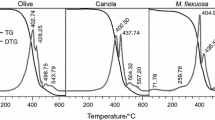Abstract
The task of obtaining oils with heightened antioxidative properties by incorporating natural antioxidative spice plant components into the receipt composition has been solved in order to decrease the intensity of possible oxidative reactions and increase the shelf life of iodine-fortified sunflower oil. It has been shown that natural antioxidants exert an effective influence on the stabilization of the investigated oils; i.e., the intensity of accumulation of primary and secondary oil oxidation products is inhibited.
Similar content being viewed by others
References
Assessment of Iodine Deficiency Disorders and Monitoring Their Elimination: A Guide for Program Managers, ICCIDD, UNICEF, WHO, Sec. Ed., 2005.
Review of Progress towards Sustainable Elimination of Iodine Deficiency in Thailand, ICCIDD, UNICEF, 2004.
Monitoring Universal Salt Iodization Programes. UNICEF/PAMM/ICCIDD/WHO, 2005, p. 100.
Pandav, C., Worthwhile Investment in Health. Economic Evaluation of IDDs Control Program in Skim. Delhi: Oxford University Press, 2007.
Progress towards the Elimination of Iodine Deficiency Disorders (IDD), WHO, UNICEF and ICCIDD, WHO/Euro/NUT/, 2006.
Hotăarâre cu privire la aprobarea programului na ional de eradicare a tulburarilor prin deficit de iod pina in anul 2010, Monitorul official al RM, 1 iunie 2007.
Starea de nutritie in Republica Moldova. Raport UNICEF, 1996–2000, p. 38.
Conferinţa “Deficien a de vitamine şi minerale. Evaluarea prejudicilor şi auditul protecţiei pentru Moldova 2006. Scurtă expunere pentru factori de deciuie”, Chişinău, Decembrie 2006.
Conferinţa Na ionala de Nutriţie, Republica Moldova, Chişinău, 28 iunie 2007.
Alimentaţia şi nutriţia umanĂ în Republica Moldova. ConstatĂri şi recomandĂri, UNICEF, Biroul pentru Moldova, 2000.
Abraham, B., Webb, K.L., Interim Evaluation of the Voluntary Iodine Fortification Program. Canberra: Australian Food and Nutrition Monitoring Unit, Commonwealth of Australia, 2006.
Food Standards Australia New Zealand. 2004a. Initial Assessment Report — Proposal P230 Iodine Fortification, Canberra: FSANZ.
Honein, M.A., Paulozzi, L.J, Mathews, T.J et al., Impact of Iodine Fortification of the US Food Supply on the Occurrence of Neural Tube Defects, JAMA 285:2981–2986, 2006.
Liu, S., West, R., Randell, E., Longerich, L., O’Connor, K. S., Scott, H., Crowley, M., Lam, A., Prabhakaran, V., McCourt, C., A Comprehensive Evaluation of Food Fortification with Iodine, BMC Pregnancy and Childbirth 4:20, 2006.
Ray, J G., Iodine Food Fortification in Canada, Nutrition Review 62:S35, 2006.
Stanley, F., Eastman, C, Mann, J., Binns, C., The Effectiveness of Mandatory Fortification as a Public Health Strategy to Increase Nutrient Intakes with Reference to Iodine and Folate, 2005, p. 24.
Winger, R.J., Koening, J., Je Lee, S. Wham and House, D.A., Technological Issues with Iodine Fortification of Foods, Final Report for New Zealand Food Safety Authority, 2005.
Budagyan, F.E. and Smirnova, L.I., The Influence of Phenol Antioxidants on Assimilability of Melted Pig Fat, Voprosy pitaniya, 2005, vol. 21, no 2, pp. 47–50.
Bukhman, N.D., The Influence of Antioxidant on Nutritive Value of Fat, Voprosy Pitaniya, 2006, vol. 21, no 1, pp. 68–72.
Faria, J.A.F., A Gas Chromatographic Reactor for Measuring the Effectiveness of Antioxidants for Polyunsaturated Lipids, J. Amer. Oil Chem. Soc., 2005, vol. 59, no 12, pp. 533–535.
Lillard, D.A., Chemical Changes Involved in the Oxidation of Lipids in Foods, in Lipids as a Source of Flavour, Washington, 2005, pp. 68–80.
Denisov, E.T., Konstanty skorosti gomologicheskikh zhidkofaznykh reaktsii (Rate Constants of Homologous Liquid-Phase Reactions), Moscow: Nauka, 1995, p. 711.
Gagarina, A.B., Pisarenko, L.M., and Emanuel, N.M., Kinetic Characteristic of Inhibiting Action of 2-Phenyldandione-1,3 in Chain Oxidation Process, Dokl. AN SSSR, 1987, vol. 212, no 3, pp. 653–656.
Moiseev, V.V. and Poluektov, I.T., 2-Aryldandiones-1,3: a New Class of Radical-Active Compounds, Uspekhi Khimii, 1994, vol. 48, no 3, pp. 471–491.
Cornell, D.G., Nielbiss, E.D., and Pallansch, M.J., Partition Coefficients of Some Antioxidants in Butter Oil-Water Model Systems, J. Dairy Sci, 2007, vol. 53, no 11, pp. 529–535.
Effectiveness in Intermediate Moisture Content Model Systems, J. Food. Sci., 2006, vol. 39, no 3, pp. 479–483.
Spravochnik po rastvorimosti (Solubility Reference Book), Moscow-Leningrad: AN SSSR, 1967, vol. 1, p. 1870.
GOST 26593-85: Method for Determining Peroxide Value of Edible Oils and Fats.
Shanta, N.C. and Decker, E.A., Rapid, Sensitive, Iron-Based Spectrophotometric Methods for Determination of Peroxides Values of Food Lipids, J. AOAC, 1994, 77, pp. 421–424.
IUPAC, Standard Methods for the Analysis of Oils, Fats and Derivatives., Method Number 2.504, 7th ed., Determination of the p-Anisidine Value (p-A/V.), Blackwell Scientific Publications, Boston, MA and Oxford, UK, 1987.
Bird, R.P. and Draper, H.H., Comparative Studies on Different Methods of Malonaldehyde Determination, Methods Enzymol., 1984, 105, pp. 184–191.
Snedecor, G.W. and Cochran, C.W., Statistical methods, Ames, IA, 8th ed., Iowa State University Press, 1989, pp. 343–438.
Popovici, C., Haritonov, S., Deseatnicov, O., Sturza, R., Study of the Incorporation of Iodine in Vegetal Oils, Journal of the University of Chemical Technology and Metallurgy, Bulgaria: UCTM, 2006, vol. 41, no 4, pp. 449–456, ISSN 1311-7629.
Deseatnicov, O., Sturza, R., Haritonov, S., Popovici, C., Issledovanie fizico-himicheskih svoistv obogashennogo iodom podsolnechnogo masla, Elektron. Obrab. Mater., 2006, no 4, pp. 73–78, ISSN 0013-5739.
Sturza, R., Deseatnicov, O., Popovici, C., Brevet de inven ie. Procedeu de obţ;inere a uleiului de fioarea-soarelui cu valoare biologică sporită. Nr. Hotărârii de acordare 5111 din 2007.04.12, Nr. depozit: a 2006 0186.
STAS 1129-93, Ulei de fioarea soarelui. Condiţii tehnice.
Author information
Authors and Affiliations
Corresponding author
Additional information
Original Russian Text © K.M. Popovich, 2008, published in Elektronnaya Obrabotka Materialov, 2008, No. 5, pp. 85–92.
About this article
Cite this article
Popovich, K.M. The influence of natural antioxidants on the oxidative stability of iodine-fortified sunflower oil in the process of storage. Surf. Engin. Appl.Electrochem. 44, 415–421 (2008). https://doi.org/10.3103/S106837550805013X
Received:
Published:
Issue Date:
DOI: https://doi.org/10.3103/S106837550805013X




